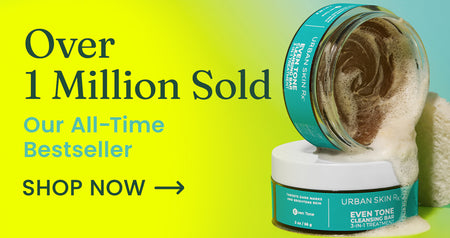What Causes Uneven Skin Tone?

With ultra-smoothing Instagram filters on the rise, uneven skin tones are more noticeable than ever. And while makeup is a powerful cover-up tool, we don't always have the time to apply layers of foundation and concealer on our way out the door.
We recommend adding a second tool to your even-skin arsenal: skincare products. The right skincare products can help even out the appearance of your skin, leaving you with one less thing to worry about. Here's a breakdown of what causes uneven skin tone and how to address it in your skincare routine.
What Is an Uneven Skin Tone?
“Uneven skin tone” is a broad term many people use to mean different things. To help clear things up, here's what we're talking about when we discuss uneven skin tone.
Blemishes
One of the most frustrating parts about breakouts is how visible they are. Blemishes are caused by irritation in your pores.
This means that blemishes can affect not only your skin's texture but also your appearance. Many blemishes have redness that can stick around even through a breakout-busting skincare routine.
Dark Spots
Dark spots are a form of hyperpigmentation that appear just as they sound: like small dark spots that can pepper your skin. In other cases, they can also appear as large dark blotches. One common form of dark spots is freckles, which result from sun damage and fade over time.
However, other dark spots don't fade as easily. These more permanent spots can easily make their home in your complexion. While some people don't mind dark spots, others find them undesirable and try to reduce their appearance.
Scarring
Another form of hyperpigmentation is scarring. While there are many sources of scarring, one of the most common sources of facial scarring is breakouts.
The same irritation that causes blemishes can also cause scar tissue to form and cause the skin to heal abnormally. Some acne scars look like small holes in the skin or just an uneven surface texture, but others can look like dark spots or even permanent red spots.
Redness
An uneven skin tone can also present itself as redness. While redness typically shows up around the cheeks, chin, and nose, it can present differently depending on the person.
Although not technically a form of hyperpigmentation, redness is still a frustrating situation that can lead to uneven skin tone. Fortunately, redness usually has an underlying cause that you can address through proper skincare.
What Causes Uneven Skin Tone?
Having an uneven skin tone can feel overwhelming, especially since it's hard to see how everything is related. However, an uneven skin tone is usually related to underlying conditions and sources that are easy to address. Here are some factors that can cause an uneven skin tone.
Dry Skin
Dry skin is a major factor in uneven skin tone, especially when it comes to redness. Dry skin is much more sensitive to dryness and harsh products, which means it can get irritated pretty frequently. A major sign of dry skin is redness.
Dry skin is also less able to bounce back from stress, which means it's more likely to scar. Since dry skin types can be prone to breakouts due to dead skin cell buildup, your chances of developing blemish-related scarring are much higher.
Dehydration
Although they may seem similar, dry and dehydrated skin are different. Dry skin is a skin type and a condition characterized by flakiness, roughness, fine lines and redness.
Meanwhile, dehydration can affect any skin type and often does so in different ways. For instance, dehydration in oily skin can lead to excess sebum production and a higher chance of developing blemishes. Dehydrated skin also appears dull and even gray in some spots.
While dry skin has difficulty pulling in water and staying hydrated, dehydrated skin simply doesn't have enough water. While dry skin is often addressed with special skincare ingredients, dehydrated skin is typically addressed with good, old-fashioned water.
Sun Exposure
Sun exposure is a huge factor in hyperpigmentation in many cases. This is because UV rays can penetrate the skin and damage skin cells.
When this happens, your cells start to increase melanin production. This is controlled by an enzyme called tyrosinase.
Hyperpigmentation is a common stress response that your skin uses to protect itself against further damage. While tanning is a widespread case of this protection tactic, it can also happen in concentrated areas. This results in dark spots.
Harsh Skincare Ingredients
The tyrosinase in your cells can also be stimulated by harsh skincare ingredients. Especially if you have sensitive skin, prescription-strength Retinoids and other powerful skincare products can shock your skin.
Your skin can develop dark spots to protect itself against this perceived threat. This is also true for ill-fitting skincare ingredients.
For instance, drying skincare ingredients may work well on oily skin but will likely just cause stress in dry skin – which can lead to dark spots.
Skin Conditions
Certain skin conditions can contribute to an uneven skin tone. These conditions are often caused by bacteria, fungus, or fundamental imbalances in the skin.
While you may be able to use skincare products to improve the visible effects of some of these conditions, over-the-counter (OTC) products alone can't treat the condition. We recommend consulting your primary care physician or dermatologist if you think your uneven skin tone is due to an underlying condition.
What Can Help Improve Skin Tone?
If you have an uneven skin tone and want to address it, we have a few tips.
First, a few lifestyle changes can help clear up the appearance of uneven skin. For instance, you can drink more water, quit smoking, and incorporate nutritious food into your diet.
Second, some common skincare ingredients can help even out the appearance of your complexion. Here are some of our favorite skincare products for an uneven skin tone.
Retinol
When it comes to uneven skin tone, Retinol is an incredibly effective ingredient. Retinol is a Vitamin A derivative that works by polishing away the top layer of skin and supporting skin cell turnover.
Turnover is the process through which the skin renews itself. Both of these functions combine to lift affected skin cells. While no product can promise to make your dark spots disappear, a Retinol product like our Retinol Rapid Repair & Dark Spot Treatment can help them fade into the background.
Alpha Hydroxy Acids
Alpha Hydroxy Acids (AHAs) are a class of ingredient that includes Lactic Acid, Glycolic Acid, Citric Acid, and Malic Acid. These acids function as chemical exfoliants and can help fade the appearance of dark spots.
Even the most powerful AHA is less potent than Retinol, meaning certain AHAs like Lactic Acid and Glycolic Acid can help even sensitive skin. One of our favorite ways to incorporate AHAs is with our Even Tone Smooth & Glow Enzyme Mask. Featuring Glycolic Acid and Lactic Acid, this mask helps to even out and brighten the appearance of your skin for a youthful-looking complexion.
Vitamin C
Vitamin C, known in the skincare world as L-Ascorbic Acid, has antioxidant properties that can help soothe some of the effects of sun damage. Since some dark spots arise from sun damage, applying Vitamin C after sun exposure may help lessen these effects.
Vitamin C can help reduce the appearance of excess pigment in the skin. Vitamin serums like our Super C Brightening Serum can fade the look of dark spots and provide your skin with the support it needs to prevent them in the future.
Kojic Acid
One of our favorite ingredients for dark spots and uneven skin tone is Kojic Acid. Sourced from mushroom extract, Kojic Acid can help fade the appearance of hyperpigmentation.
Kojic Acid can also help brighten the appearance of blemish scars, as well as have an overall brightening effect on your complexion. You can take advantage of these benefits and more with our Dark Spot and Even Tone Essentials Package.
Azelaic Acid
While the main skincare acids are AHAs and Beta Hydroxy Acids (BHAs), Kojic Acid and Azelaic Acid belong to their own categories. Azelaic Acid is a natural compound found in grains such as barley, rye, and wheat.
Azelaic Acid comes in both prescription-strength and OTC formulations. Since it's much gentler than AHAs, this ingredient is often suggested for those with sensitive skin. That's why we included Azelaic Acid in our Even Tone Super Glow Serum.
Licorice Root
Licorice Root Extract is a game-changing ingredient just now making its way into the skincare world. This ingredient can target current dark spots to help them fade more quickly.
Licorice Root Extract can also help your skin stay hydrated, which can help prevent dryness. Since dryness often leads to redness, this is a great ingredient for red discoloration. You can incorporate Licorice Root Extract into your skincare routine with our Witch Hazel Brightening & pH Balancing Toner.
Niacinamide
This ingredient is very popular in the skincare world, so you've probably seen it before. Niacinamide is just the dermatology term for Vitamin B3, and it can also be listed as Nicotinamide.
Niacinamide is an overall wonder ingredient that can help reduce the appearance of blemishes, soothe irritated skin, encourage hydration, and fade dark spots. As an added bonus, Niacinamide is also excellent for sensitive skin due to its soothing properties. If you want to incorporate Niacinamide into your skincare routine, we recommend trying our Advanced Even Tone Day & Night Treatment.
In Conclusion
“Uneven skin tone” is a broad term that basically refers to any type of discoloration on your facial skin. Many factors can affect your complexion, but some of the main ones we see are dry skin, dehydration, sun exposure, harsh skincare ingredients or products, and certain skin conditions.
Fortunately, skincare ingredients like Kojic Acid, Vitamin C, and Licorice Root can help even out your tone. Instead of covering up your uneven skin, let us help you put together a skincare routine that evens your complexion at the source.
Engagement Manager




